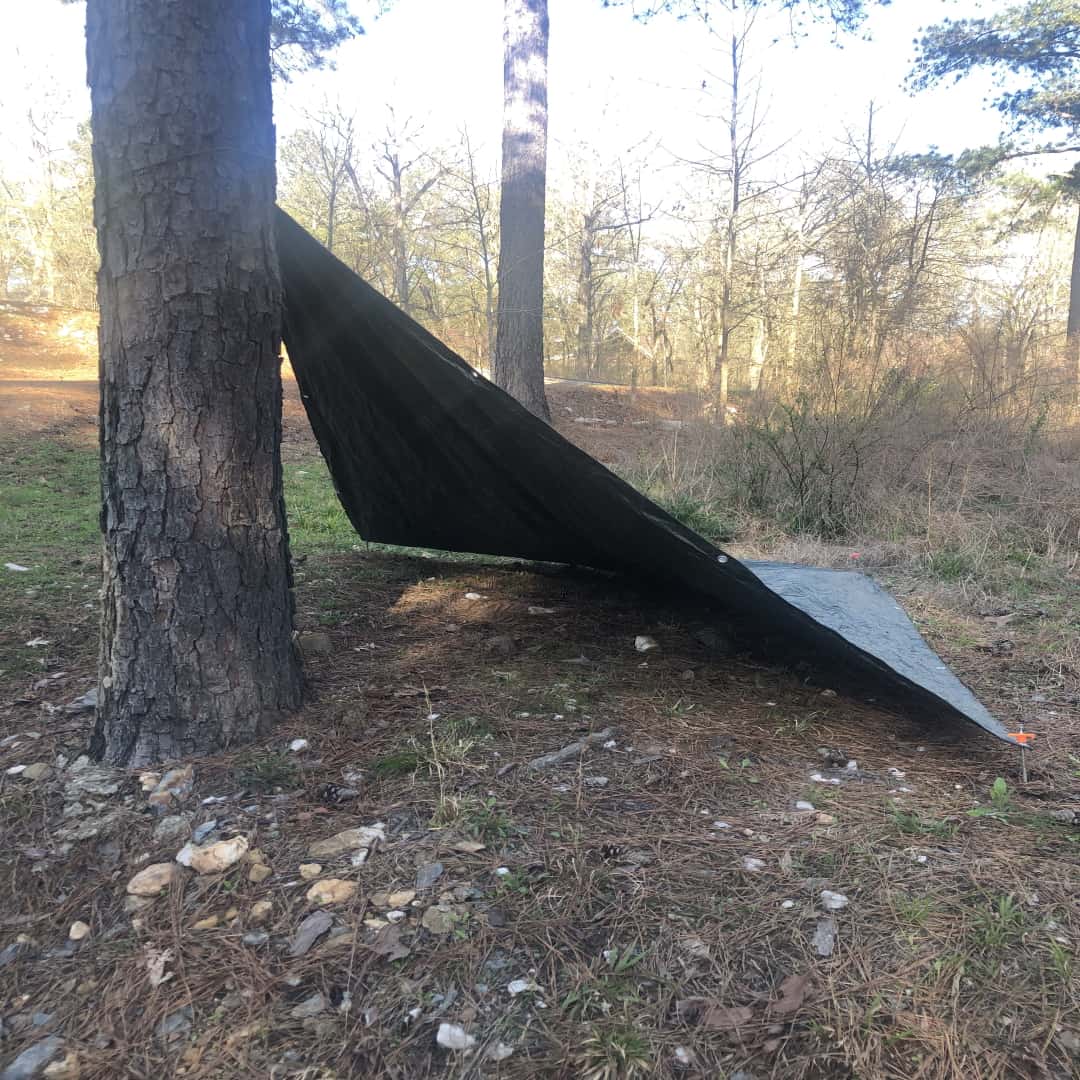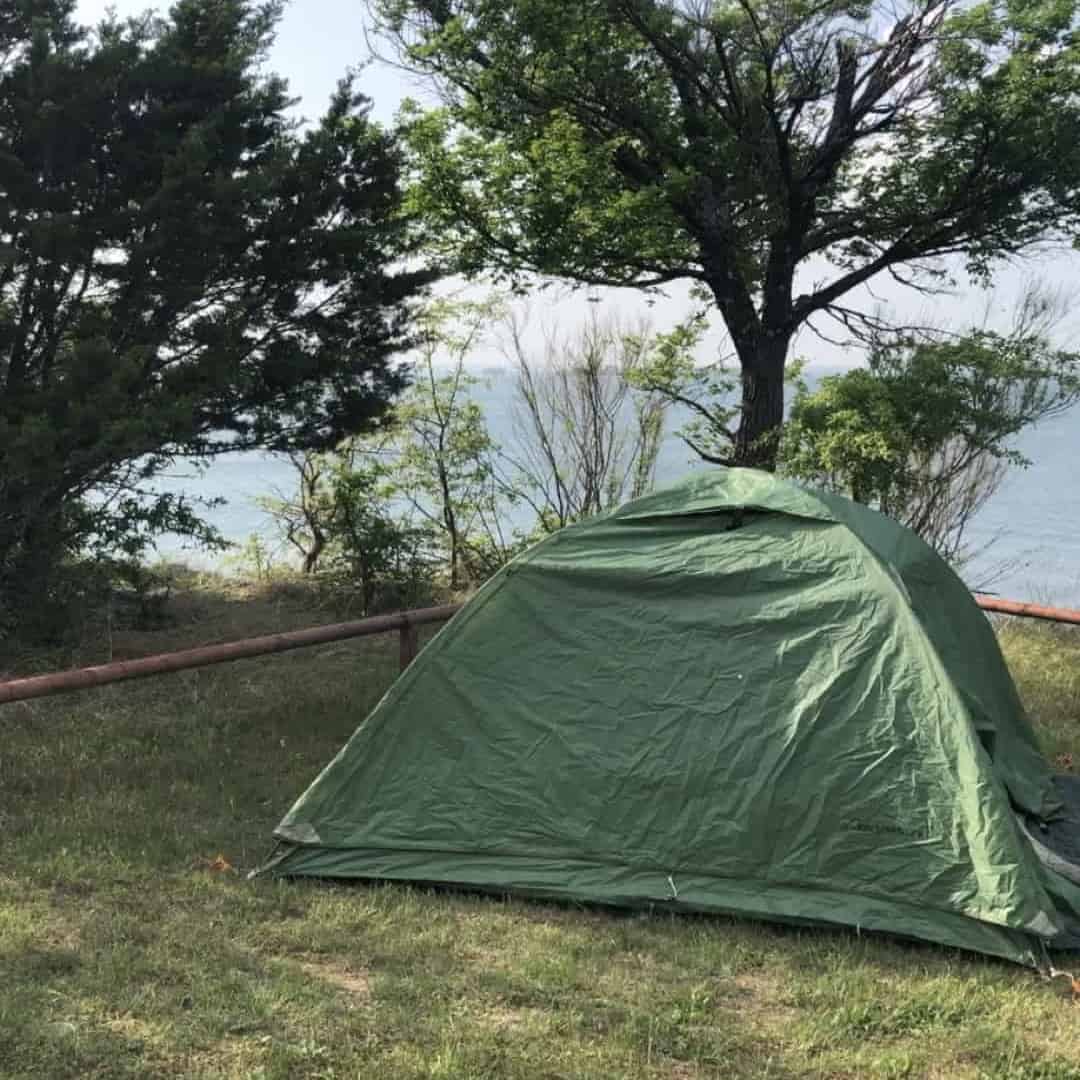Backpacking Tarp Vs Backpacking Tent For Shelter
If you click and purchase with one of our links, we earn a commission. Thanks.
Backpacking is combines hiking and camping. Whether you are hiking a couple of miles for a weekend trip or several months on a thru-hike, every backpacker must have adequate shelter on their trip. If you’re not going to sleep in a hammock, then you must decide between a tent or tarp. Tarps are rectangular pieces of material, often plastic, that can be assembled into a shelter while on the trail. Tents resemble the a-frame or teepee tarp shelters but there are two important differences. One difference is that tents often come with poles that allow them to stand on their own. The second, and most important difference is that tents have floors and doors to keep bugs, lizards, and snakes out. Because tents are fully enclosed, they do a better job at keeping you dry. But tarps are often lighter weight. Whether you choose a tent or a tarp for backing, is a personal decision.
In this article, we will take a deeper look at the pros and cons of each approach.
Is A Tarp A Tent?

A common question by beginners is “is a tarp a tent?”
The short answer is no.
Tents have distinct differences from tarps.
A tent has a floor. The floor is important. A floor keeps water away from your sleeping bag, pad, and gear. The floor also provides protection from bugs, lizards, snakes, and other wildlife.
The walls of the tent are connected to the floor. This provides further protection from insects, rain, and wind.
Tents also come with poles that provide structure to the tent. Note, some tents use trekking poles instead of traditional poles. They are a compromise between a tarp shelter and a backpacking tent.
Are Tarps Lighter Than Tents
Tarps are lighter than tents. Because tarps are lighter than tents is what makes them so desirable by backpackers.
The lightest tarp shelter I own is a combination poncho and tarp system. It weighs 12 ounces. The lightest traditional tarp I own weighs a little over 1 pound. Meanwhile, the lightest tent I own is a 1 person backpacking tent that weighs 2.7 pounds. Even my trekking pole tent weighs about 3 pounds.
2 pounds doesn’t sound like much. But it adds up. In particular, if you are camping in an area without access to water. When backpacking without reliable access to water sources, you must carry more water. And that 2 pounds are an extra liter of water you can carry.
How Do You Sleep Under A Tarp?
There are several variations for tarp shelter construction. The simplest is an A-Frame. You tie cordage like paracord between two trees forming a ridgeline. You then hang the tarp over the ridgeline.
Other variations include the plowhead which only requires one tree or fence post. This is the fastest shelter to assemble. My record is 90 seconds. Speed is important with a plowhead because if you start getting rained or snowed on, you need to move it quickly to put the tarp in the direction of the precipitation.
If there are no trees, you can use a trekking pole to form a teepee. This will be a very warm shelter and I wouldn’t use it in the south in warm weather.
Once you have your shelter configure, then you lay down your sleeping pad and unroll your sleeping bag. If you can, hang your backpack to keep it from getting wet or bugs. Also put your socks in your boots or shoes to avoid having spiders, scorpions, or snakes crawl into them.
When To Use A Tarp Tent?
There are 2 primary reasons to use a tarp tent.
If you’re an experienced backpacker, you might enjoy the weight reduction of a tarp. Whether this means you can carry more water, more food or a comfort item is up to you. Heck, you might just enjoy carrying less weight instead of replacing the tent weight with other stuff.
The other reason to use a tarp tent is for emergency use. I always encourage people to take tarps with them on day hikes. Even if it’s just an emergency thermal blanket. You never know when you need to have an unplanned camping trip because you busted an ankle.
Tarp Camping In The Rain
The entire reason to use a tarp for a shelter is to protect you from the elements. Otherwise, if it’s not going to rain, then layout your tarp on the ground and cowboy camp. The tarp will protect from moisture. And provide additional incentives for any snakes in the area to look for another place to slither. Plastic is not a surface a snake naturally travels on so it will want to avoid it. Tarp Camping And Bugs One of the downsides to tarp camping is that you don’t have any protection from bugs. However, there are steps you can take to reduce your exposure.
First, you can backpack in cooler weather when the insects are not active.
Second, you can spray everything with permethrin which is an insect repellent that is designed for clothing and gear.
Third, you can bring bug netting with you. This is additional weight but it’s still going to weigh less than a complete tent.
Avoiding rain and insects is why most people don’t want to sleep with only a tarp over them on a backpacking trip.
Tarp Camping In The Winter
Ironically, tarp camping might be better than tents in the winter. You might be puzzled by this because a tent has 4 walls. But those walls are only a couple of inches of nylon. They’re not insulated.
And you can’t have a fire in a tent.
Meanwhile, it’s possible to build a small fire and arrange your tarp so that the radiant heat bounces off the tarp. I’ve seen tarp shelters where the tarp-protected area is in the 60s, while outside ambient temperatures are in the 30s.
However, in strong wind, a tarp will not do as good of job as a tent at protecting you.
Are Trekking Poles Tents The Perfect Backpacking Tent?
Tent poles add the most weight to a tent. Thus, if you can avoid carrying tent poles, you should consider this.
While some people will opt to share a tent and split the load, there is another option. Which is to bring along a trekking pole tent.
A trekking pole tent uses your trekking poles as the tent poles. I find these tents the fastest to setup and by adding extra guidelines, they’re stable.
If you lose your trekking poles, you can use sticks to hold the tent up or tie them to trees similar to an A-Frame tarp shelter.
How To Decide Between A Tarp And Backpacking Tent?

To maximize safety and comfort, you should bring a tent. Even after you have been a dozen backpacking trips, a tent is still a better option than a tarp.
Tents are better than tarps because of three things.
First, a tent provides four walls and a floor. The four walls and a floor provide maximum protection from the elements. While a tent by itself will not keep you warm, a tent shields you from the rain, snow, and wind which makes it easier for your sleeping system to keep you warm.
Second, a tent provides better protection from bugs. While you can bring bug netting with you for a tarp, the DIY netting setup is not going to work as well as a tent. Not only is the bug netting already attached to the tent, as long as you keep your zippers closed, it will also be almost impossible for spiders, beetles, mosquitoes, etc to crawl in.
Third, a tent doesn’t require any special skills to setup. Modern free-standing backpacking tents will work on any terrain with flat ground. Meanwhile, with a tarp, unless you possess the proper skills, you will be challenged to configure a tarp shelter without trees.
Tarp shelters are appropriate in 3 conditions.
The first condition is for confidence building. Whether it is to improve your own confidence in the outdoors or as part of an exercise with a scout troop, building a tarp shelter is a great confidence builder.
The second condition is to provide shade or rain coverage outside your tent. For example, we build a tarp shelter to cook under for our group. You can also do this to provide coverage of an exposed picnic table at a state park. A rain tarp shelter can also be used to provide shade in the summer.
The third condition is for emergency use. If you are out on a day hike and a surprise storm pops up, you can pull out your tarp and assemble a shelter to keep you dry until the rain passes.